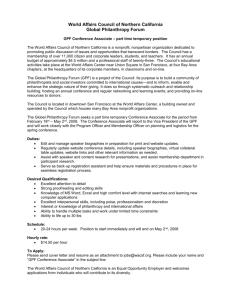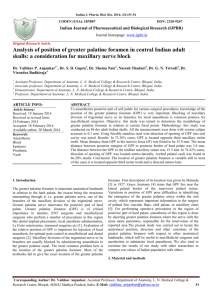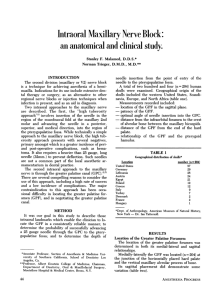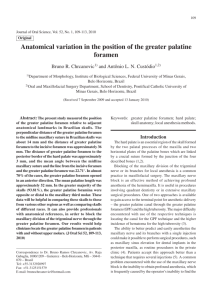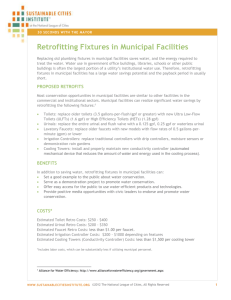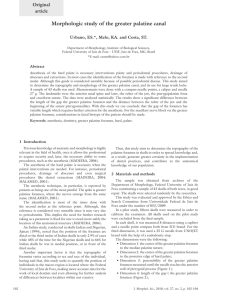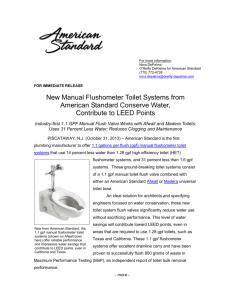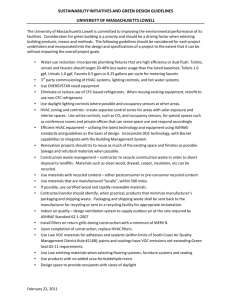Anatomical and clinical considerations regarding the greater
advertisement
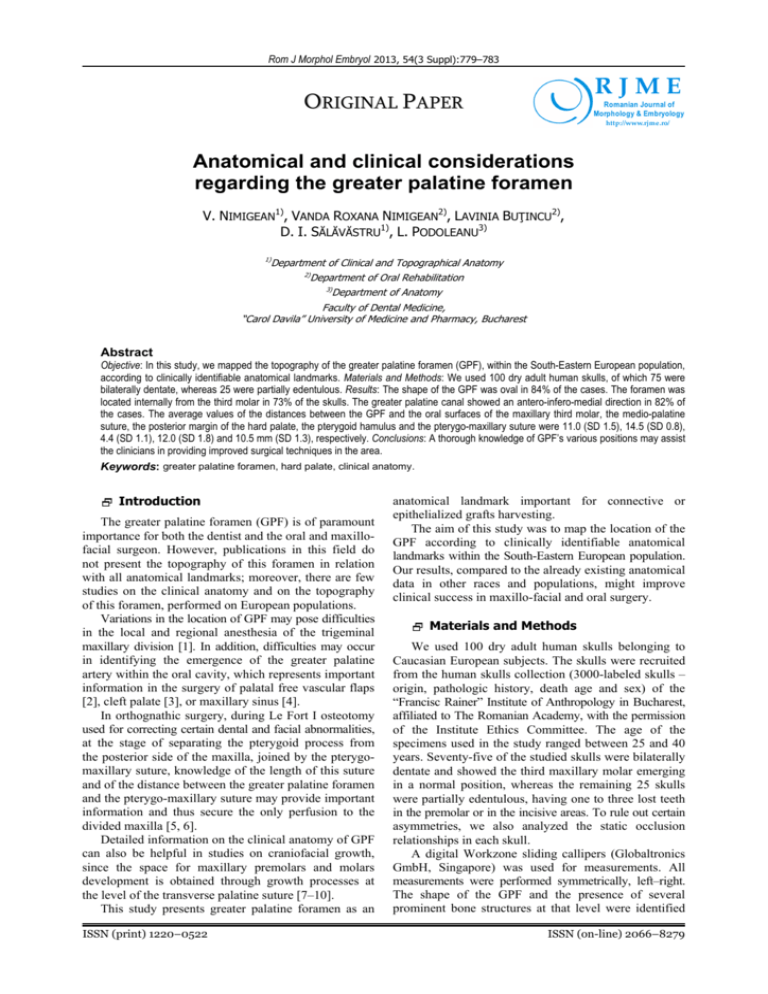
Rom J Morphol Embryol 2013, 54(3 Suppl):779–783 RJME ORIGINAL PAPER Romanian Journal of Morphology & Embryology http://www.rjme.ro/ Anatomical and clinical considerations regarding the greater palatine foramen V. NIMIGEAN1), VANDA ROXANA NIMIGEAN2), LAVINIA BUŢINCU2), D. I. SĂLĂVĂSTRU1), L. PODOLEANU3) 1) Department of Clinical and Topographical Anatomy 2) Department of Oral Rehabilitation 3) Department of Anatomy Faculty of Dental Medicine, “Carol Davila” University of Medicine and Pharmacy, Bucharest Abstract Objective: In this study, we mapped the topography of the greater palatine foramen (GPF), within the South-Eastern European population, according to clinically identifiable anatomical landmarks. Materials and Methods: We used 100 dry adult human skulls, of which 75 were bilaterally dentate, whereas 25 were partially edentulous. Results: The shape of the GPF was oval in 84% of the cases. The foramen was located internally from the third molar in 73% of the skulls. The greater palatine canal showed an antero-infero-medial direction in 82% of the cases. The average values of the distances between the GPF and the oral surfaces of the maxillary third molar, the medio-palatine suture, the posterior margin of the hard palate, the pterygoid hamulus and the pterygo-maxillary suture were 11.0 (SD 1.5), 14.5 (SD 0.8), 4.4 (SD 1.1), 12.0 (SD 1.8) and 10.5 mm (SD 1.3), respectively. Conclusions: A thorough knowledge of GPF’s various positions may assist the clinicians in providing improved surgical techniques in the area. Keywords: greater palatine foramen, hard palate, clinical anatomy. Introduction The greater palatine foramen (GPF) is of paramount importance for both the dentist and the oral and maxillofacial surgeon. However, publications in this field do not present the topography of this foramen in relation with all anatomical landmarks; moreover, there are few studies on the clinical anatomy and on the topography of this foramen, performed on European populations. Variations in the location of GPF may pose difficulties in the local and regional anesthesia of the trigeminal maxillary division [1]. In addition, difficulties may occur in identifying the emergence of the greater palatine artery within the oral cavity, which represents important information in the surgery of palatal free vascular flaps [2], cleft palate [3], or maxillary sinus [4]. In orthognathic surgery, during Le Fort I osteotomy used for correcting certain dental and facial abnormalities, at the stage of separating the pterygoid process from the posterior side of the maxilla, joined by the pterygomaxillary suture, knowledge of the length of this suture and of the distance between the greater palatine foramen and the pterygo-maxillary suture may provide important information and thus secure the only perfusion to the divided maxilla [5, 6]. Detailed information on the clinical anatomy of GPF can also be helpful in studies on craniofacial growth, since the space for maxillary premolars and molars development is obtained through growth processes at the level of the transverse palatine suture [7–10]. This study presents greater palatine foramen as an ISSN (print) 1220–0522 anatomical landmark important for connective or epithelialized grafts harvesting. The aim of this study was to map the location of the GPF according to clinically identifiable anatomical landmarks within the South-Eastern European population. Our results, compared to the already existing anatomical data in other races and populations, might improve clinical success in maxillo-facial and oral surgery. Materials and Methods We used 100 dry adult human skulls belonging to Caucasian European subjects. The skulls were recruited from the human skulls collection (3000-labeled skulls – origin, pathologic history, death age and sex) of the “Francisc Rainer” Institute of Anthropology in Bucharest, affiliated to The Romanian Academy, with the permission of the Institute Ethics Committee. The age of the specimens used in the study ranged between 25 and 40 years. Seventy-five of the studied skulls were bilaterally dentate and showed the third maxillary molar emerging in a normal position, whereas the remaining 25 skulls were partially edentulous, having one to three lost teeth in the premolar or in the incisive areas. To rule out certain asymmetries, we also analyzed the static occlusion relationships in each skull. A digital Workzone sliding callipers (Globaltronics GmbH, Singapore) was used for measurements. All measurements were performed symmetrically, left–right. The shape of the GPF and the presence of several prominent bone structures at that level were identified ISSN (on-line) 2066–8279 780 V. Nimigean et al. by visual examination. For each skull, we measured (Figure 1): ▪ Antero-posterior and transverse diameters of the GPF; ▪ The relationship between the GPF and the palatal site of maxillary molars (PT distance); ▪ The distance between the GPF and the mediopalatine suture (PMP distance); ▪ The distance between the GPF and the posterior margin of the hard palate (PPP distance); ▪ The distance between the GPF and the pterygoid hamulus (PH distance); ▪ The distance between the GPF and the pterygomaxillary suture (PPtM distance). The location of needle piercing had been established after a corroborated analysis of the bones and of the soft tissue constituting the topography of the GPF. Results After examining the static occlusion, the existence of a neutral sagittal molar relationship was confirmed in all the skulls. In 84 (84%) skulls, the shape of GPF was oval, antero-posteriorly elongated, whereas in the remaining 16 (16%) skulls its shape was circular. Regarding the prominent bone structures at the level of GPF, in 13 (13%) skulls the posterior margin was slightly thicker and more prominent, without bone extensions reducing the diameter of the foramen. The mean antero-posterior diameter of the GPF was 4.9 mm (SD 0.9, range 3 to 7 mm, Q1 – 4.3 mm and Q3 – 5.5 mm). The mean transversal diameter of the GPF was 3 mm (SD 0.9, range 2 to 4 mm, Q1 – 2.6 mm and Q3 – 3.4 mm). The relationship between the GPF and the maxillary molars was as follows: ▪ In 73 (73%) skulls the foramen was situated opposite to the third molar; ▪ In 15 (15%) skulls the foramen was situated opposite to the space between the second and the third molars; ▪ In nine (9%) skulls the foramen was situated opposite to the second molar (Figure 2); Figure 1 – Illustration of the measurements performed. GPF: Greater palatine foramen, 1. PT distance, 2. PMP distance, 3. PPP distance, 4. PH distance, 5. PPtM distance (see text for explanation). To increase measurement accuracy in what concerns the relationship between the GPF and the maxillary molars, a flexible probe (0.5 mm in diameter and 5 cm in length) was fixed with putty silicon in the GPF, and a straight graduated ruler, adjusted to the palate width in the molar area, was used for measurements. The data obtained were analyzed with the STATA/ SE11 statistical software. The mean, standard deviation, the minimum, maximum, the median, Q1 and Q3 were calculated. Additionally, we evaluated the inclination of the greater palatine canal with respect to the medio-sagittal and transversal planes corresponding to the palatine sutures, by introducing a flexible probe into the canal (0.5 mm in diameter and 10 cm in length), as the skulls had been fixed on a side in a prop, in such a way that the external base remained free, allowing the measurement. We also studied the appearance and the thickness of the palatine mucous membrane in the area of the GPF on 50 adult patients with complete dentition and no dental or oral mucous membrane lesions, by means of inspection with magnitude 6 binocular magnifying glasses. For thickness measurement, we used flexible Miller probes equipped with rubber sterile marks, having previously anesthetized the mucous membrane. Figure 2 – Greater palatine foramen situated opposite to the second molar. ▪ In three (3%) skulls, the foramen was situated behind the third molar. Measurements of the PT distance (the distance between the oral surfaces of the last two molars at the level of the cemento-enamel junction and the GPF) showed: ▪ Average PT at the level of the third molar: 11.0 mm (SD 1.5, range 7 to 14.8 mm, Q1 – 10.4 mm and Q3 – 11.8 mm); ▪ Average PT at the level of the second molar, distal surface: 11.9 mm (SD 1.7, range 8.5 to 16.1 mm, Q1 – 10.7 mm and Q3 – 12.7 mm). The direction of the greater palatine canal had an anteromedial direction in the majority of the skulls (82%) and in conjunction with the medio-sagittal plane, it formed a variable angle of 2–100 (mean value, 60). In 13% of the skulls, the canal had an anterior inclination, and in the remaining 5% of the skulls, the canal was vertical. Anatomical and clinical considerations regarding the greater palatine foramen Mean PMP distance was 14.5 mm (SD 0.7, range 13.1 to 16.1 mm, Q1 – 14.0 mm and Q3 – 15.0 mm). Mean PPP distance was 4.4 mm (SD 1.1, range 2 to 7 mm, Q1 – 3.5 mm and Q3 – 5.4 mm). Mean PH distance was 12.0 mm (SD 1.8, range 8.1 to 16 mm, Q1 – 10.6 mm and Q3 – 13.3 mm). Finally, mean PPtM distance was 10.5 mm (SD 1.3, range 7.5 to 13.5 mm, Q1 – 9.7 mm and Q3 – 11.5 mm). Regarding the appearance of the palatine mucous membrane, in 74 (74%) patients, we observed that the 781 mucous membrane corresponding to the GPF was slightly lighter in color and had a small, shallow, funnel-like area. The mean thickness of the mucous membrane covering the GPF was 6 mm (range 4 to 8 mm). All measurements were performed separately for the left and the right side of the skulls, but the differences analyzed by paired t-tests were statistically insignificant in all measurements. Descriptive data of our study are shown in Table 1. Table 1 – Measured parameters in the skulls (values in millimeters) Parameters Mean SD Minimum Maximum Q1 Median Q3 GPF antero-posterior diameter GPF transversal diameter rd PT (3 molar) distance nd PT (2 molar) distance PMP distance PPP distance PH distance PPtM distance 4.9 3.0 11.0 11.9 14.5 4.4 12.0 10.5 0.9 0.5 1.5 1.7 0.8 1.1 1.8 1.3 3.0 2.0 7.0 8.5 13.1 2.0 8.1 7.5 7.0 4.0 14.8 16.1 16.1 7.0 16.0 13.5 4.3 2.6 10.4 10.7 14.0 3.5 10.6 9.7 5.0 3.1 11.0 11.9 14.5 4.4 12.1 10.6 5.5 3.4 11.8 12.7 15.0 5.4 13.3 11.5 No statistically differences between right and left sides. Discussion The most important criterion in the selection of the skulls for this study was the absence of any significant asymmetries owed to extensive resorption consecutive to edentulism. Furthermore, we performed an occlusion analysis for each specimen to identify any left–right asymmetries. However, this criterion for selecting the material of the study is absent from previous similar reports. In the present study, the GPF was localized using easily identifiable marks, according to clinical experience gained during regional anesthesia procedures, with the exception of the pterygo-maxillary suture, which is quite difficult to be explored clinically. Lack of a molar could be compensated by the presence of the other molars or by the opposite molars. We found that 84% of the GPF were oval, anteroposteriorly elongated, while the remaining 16% were round. These findings are consistent with previous reports on different populations [5, 11, 12]. In the latter report, the authors found oval shape in 97% of the cases. The presence of bone prominences at the level of the GPF was only 13% in this study, and in this regard it differs significantly from other studies [12, 13], although Westmoreland EE and Blanton PL (2005) [10] in a study of subjects from various ethnic origin found similar rate with the present study (Table 2). Some authors, Jaffar AA and Hamadah HJ (2003) [12], consider the presence of bone prominences important in prosthetic dentistry, but we believe that their clinical relevance is minimal, because the mucous membrane covering the GPF is quite thick to prevent a pressure lesion in patients with removable prostheses. The average palate width of 46.9 mm in the molar area, which was higher compared to other studies [12], is consistent and correlated with other transversal measurements, such as PMP and PT distances, in conjunction with the transversal diameter of GPF. Therefore, we do not consider it an ethnic variation. Regarding the relationship between the GPF and the maxillary molars, in most cases (73%), it was located opposite to the third molar, and if we also consider the cases in which it was placed medially (15%), and distally (3%), from this tooth, we may conclude that in 91% of the cases the GPF is in the vicinity of the third molar. Therefore, it appears that the third molar is an important landmark for identifying the GPF, which should be always considered by the clinician. Similar rates were reported by other studies [5, 10, 12–15], except one reference [1], according to which the GPF is most frequently located opposite the second molar. These data make us state that there are no ethnic diversities on this issue either (Table 2). The average PT distances at the level of the third molar, of 11.0 mm (SD 1.5) and distally from the second molar of 11.9 mm (SD 1.7), represent additional important and accessible data in locating the GPF, which have not been discussed in previous studies. Table 2 – Studies reporting relationships between GPF and different anatomical landmarks PMP distance PPP distance Presence of bone GPF’s location with respect to [mm] [mm] prominences [%] the maxillary third molar [%] Westmoreland EE and Blanton PL (1982) [10] 15 1.9 16 90.3 Hassanali J and Mwaniki D (1984) [14] – – – 89.6 Wang TM et al. (1988) [15] 16 4.1 – 82 Ajmani ML (1994) [13] 14.7 3.7 24.6 89.6 Kim HJ et al. (1998) [5] – 3.6 – 94.4 Jaffar AA and Hamadah HJ (2003) [12] 15.7 4.8 64 88 Methathrathip D et al. (2005) [11] 16.2 2.1 – 93 Our study 14.5 4.4 13.0 91.0 Study 782 V. Nimigean et al. The direction of the greater palatine canal and its variations are important, either for the anesthetic approach to the round foramen of the maxillary division of the trigeminal nerve [16–18], or for the infiltration with vasoconstrictor anesthetic solution of the pterygo-palatine fossa intending to reduce bleeding in maxillary sinus surgery [7]. According to our results, the canal had anteroinfero-medial direction in 82% of the cases. These data differ from previous studies, in which the canal had commonly anterior direction, 90.5% in Chinese [15] and 62.4% in Indians [9]; antero-medial direction, 60% in Caucasians [12] and 58.5% in Nigerians [13] or vertical direction, 82% in a multinational study [10]. We do not believe that the significant discrepancies in these reports concerning the greater palatine canal inclination are caused by ethnic variations according to Wang TM et al. (1988) [15], but in our opinion these are the result of different criteria implemented in measurements by various authors, as well as different and probably inaccurate methods used. In most cases analyzed in this study, the greater palatine canal formed a variable angle with the mediosagittal plane of 60 (range 20 to 100), a finding similar to Methathrathip D et al. (2005) [11] report, in which an average angle of 60 to 70 was found. The authors emphasized that either the orbit (31%), or brain (8.7%), can be affected following the attempt to penetrate the greater palatine canal towards the round foramen. This explains why greater palatine canal inclination is important, and, to avoid failures, it is useful to calculate in advance the length of the canal and of the pterygo-palatine fossa, adding the covering mucous membrane thickness, thus being able to estimate the depth and the direction of the injection. The average value of the thickness of the mucous membrane covering the GPF was 6 mm, a finding consistent with other studies, 6.7 mm [11] or 6.9 mm [4]. The appearance of the palatine mucous membrane covering the GPF, which was slightly lighter in color and had a small, shallow, funnel-like area, is a useful feature, which may be taken into account in local anesthesia in the palatine region. From previous research, we have found that the loose connective tissue is better represented at the level of the mucous membrane around the GPF, which facilitates anesthetic diffusion, but also perineural expansion of tumors in the pterygo-palatine fossa and then intracranially, through the round foramen [19]. The PH distance had a mean value of 12.0 mm (SD 1.8), but it is not possible to compare it with similar studies because these data have not been previously investigated. However, we believe that this is an important landmark, because it can be used by the oralmaxillo-facial surgeon for identifying the pterygomaxillary suture by means of the pterygoid hamulus, which is palpable in the postero-lateral side of the soft palate, a prominence lying at about 2 mm posteriorly from the suture. The distance between the GPF and the pterygomaxillary suture (PPtM) had a mean value of 10.5 mm (SD 1.3). This information can be useful in orthognathic surgery at the time of separating the elements, which form the pterygo-maxillary suture, a procedure that must be performed only when there is deep knowledge of the surrounding anatomy. Kim HJ et al. (1998) [5] analyzed in detail the importance of this suture and presented close values to ours: 10.4 (SD 1.8) mm in men and 9.4 (SD 1.6) mm in women. The average value of the PMP distance, which was 14.5 mm (SD 0.8), should also be taken into account, because it is an accessible mark, because the palatine raphe, a narrow mucous membranous band of lighter color visible through inspection in all the 50 investigated patients, corresponds to the medio-palatine suture. Other studies show close values in the PMP distance [10, 11, 13] (Table 2). Aterkar S et al. (1995) [9] pointed out that these values increase in edentulism, therefore this distance may become variable according to palate width. The value of the PPP distance, which was 4.4 mm (SD 1.1), is consistent with other studies [12, 15]. However, in other studies it was lower [1, 10, 11] (Table 2). From clinical perspective, this landmark is easily identifiable, due to the ‘Ah’ line, a narrow mucous membranous band of lighter color, corresponding to the posterior margin of the hard palate. This feature was easily identified through visual inspection in all the 50 investigated patients. The different location of the GPF from the posterior margin of the hard palate can be explained by growth process at the level of the transverse palatine suture and by the fact that palate length increases in the area located anteriorly from this suture after the eruption of the lateral teeth, whereas the growth process is significantly reduced at the area located posteriorly from the suture. Hence, the PPP distance does not significantly change with age. We recommend locating the landmark, but we do not consider it the most practical and convenient for the clinician, even if references in the field state that this distance is not different in dentate as compared to edentulous adults [9]. From clinical perspective, it should be stressed that in-depth knowledge of these landmarks is very important, because the GPF represents the most important site in the palatine area, having the greatest and most precise representation in the somato-sensitive cortex, as compared to the other anatomical elements in this region [20]. By establishing the statistics values Q1 and Q3, we can easily determine the percentage of 50% of the cases showing the various parameters measured values close to the mean one. In addition, this allows the appreciation of those 25% of cases with values of the various parameters measured, close to the minimum value and the 25% of the cases with the values of the various parameters measured, close to the maximum value. Particularly in this study is that it examines both visible and clinically undetectable anatomical landmarks for locating GPM, or soft tissue and bone landmarks with reference to the increasingly frequent use of the hard palate mucosa in periodontal plastic surgery. Easily detectable clinical landmarks, such as ‘Ah’ line, the third or second molar and median raphe are sufficient to clinically locate GPM and protect the vasculonervous elements during epithelialized and connective grafts harvesting procedures. Clinically imperceptible and difficult to locate landmarks Anatomical and clinical considerations regarding the greater palatine foramen such as pterygoid hamulus and pterygo-maxillary suture cannot be used to clinically locate GPM, but are important in orthognathic surgery. Only under these circumstances, radiographic method of localization (Computed Tomography – CT) may be useful. We consider it is much more beneficial to locate the greater palatine foramen by means of clinically detectable landmarks and that CT is an unjustified examination. For this reason, our study becomes useful to practitioners treating patients from among South-Eastern European population. Conclusions The GPF may be an anatomical obstacle in oral and maxillofacial surgery procedures in the posterior area of the palate. Knowledge of the variations in its position can help the clinicians in providing improved surgical procedures. Details on clinical anatomy of GPF can also be helpful in evaluating and predicting craniofacial growth. Contribution Note The authors contributed equally to this paper. [7] [8] [9] [10] [11] [12] [13] [14] [15] References [1] Blanton PL, Jeske AH; ADA Council on Scientific Affairs; ADA Division of Science, The key to profound local anesthesia: neuroanatomy, J Am Dent Assoc, 2003, 134(6):753–760. [2] Ducic Y, Herford AS, The use of palatal island flaps as an adjunct to microvascular free tissue transfer for reconstruction of complex oromandibular defects, Laryngoscope, 2001, 111(9): 1666–1669. [3] Jones RG, The reduction of bleeding in hare-lip and cleftpalate surgery, Br J Anaesth, 1962, 34(7):481–488. [4] Douglas R, Wormald PJ, Pterygopalatine fossa infiltration through the greater palatine foramen: where to bend the needle, Laryngoscope, 2006, 116(7):1255–1257. [5] Kim HJ, Choi JH, Hur KS, Park HS, Chung IH, Clinical anatomy of the skull related to maxillary osteotomy in Koreans, Korean J Phys Anthropol, 1998, 11(1):147–154. [6] Kretschmer WB, Baciut G, Dinu C, Baciut M, Barbur I, Muste A, Dietz K, The influence of expansion on intraoperative [16] [17] [18] [19] [20] 783 bone blood flow in multisegmental maxillary osteotomies: an experimental study, Int J Oral Maxillofac Surg, 2010, 39(3): 282–286. Sejrsen B, Kjaer I, Jakobsen J, Human palatal growth evaluated on medieval crania using nerve canal openings as references, Am J Phys Anthropol, 1996, 99(4):603–611. Harnet JC, Lombardi T, Lutz JC, Meyer P, Kahn JL, Sagittal craniofacial growth evaluated on children dry skulls using V2 and V3 canal openings as references, Surg Radiol Anat, 2007, 29(7):589–594. Aterkar S, Rawal PM, Kumar P, Position of greater palatine foramen in adults, J Anat Soc India, 1995, 44(2):126–133. Westmoreland EE, Blanton PL, An analysis of the variations in position of the greater palatine foramen in the adult human skull, Anat Rec, 2005, 204(4):383–388. Methathrathip D, Apinhasmit W, Chompoopong S, Lertsirithong A, Ariyawatkul T, Sangvichien S, Anatomy of greater palatine foramen and can and pterygopalatine fossa in Thais: considerations for maxillary nerve block, Surg Radiol Anat, 2005, 27(6):511–516. Jaffar AA, Hamadah HJ, An analysis of the position of the greater palatine foramen, J Basic Med Sci, 2003, 3(1):24–32. Ajmani ML, Anatomical variation in position of greater palatine foramen in the adult human skull, J Anat, 1994, 184(Pt 3): 635–637. Hassanali J, Mwaniki D, Palatal analysis and osteology of the hard palate of the Kenyan African skulls, Anat Rec, 1984, 209(2):273–280. Wang TM, Kuo KJ, Shih C, Ho LL, Liu JC, Assessment of the relative locations of the greater palatine foramen in adult Chinese skulls, Acta Anat (Basel), 1988, 132(3):182–186. Slavkin HC, Canter MR, Canter SR, An anatomic study of the pterygomaxillary region in the craniums of infants and children, Oral Surg Oral Med Oral Pathol, 1966, 21(2):225– 235. Salagaray Lafargue F, Les «sites» de l’anesthésie locale, Actual Odontostomatol, 1992, 179:433–451. Carpentier P, Les voies sensitives trigéminales: un guide pour l’anesthésie, Actual Odontostomatol, 2008, 243:207– 223. Yamamoto M, Curtin HD, Suwansa-ard P, Sakai O, Sano T, Okano T, Identification of juxtaforaminal fat pads of the second division of the trigeminal pathway on MRI and CT, AJR Am J Roentgenol, 2004, 182(2):385–392. Bessho H, Shibukawa Y, Shintani M, Yajima Y, Suzuki T, Shibahara T, Localization of palatal area in human somatosensory cortex, J Dent Res, 2007, 86(3):265–270. Corresponding author Vanda Roxana Nimigean, Senior Lecturer, PhD, Head of Oral Rehabilitation Department, Faculty of Dental Medicine, “Carol Davila” University of Medicine and Pharmacy, 8 Eroilor Sanitari Avenue, 5th Sector, 050474 Bucharest, Romania; Phone +40721–561 848, e-mail: vandanimigean@yahoo.com Received: May 10, 2013 Accepted: August 30, 2013

